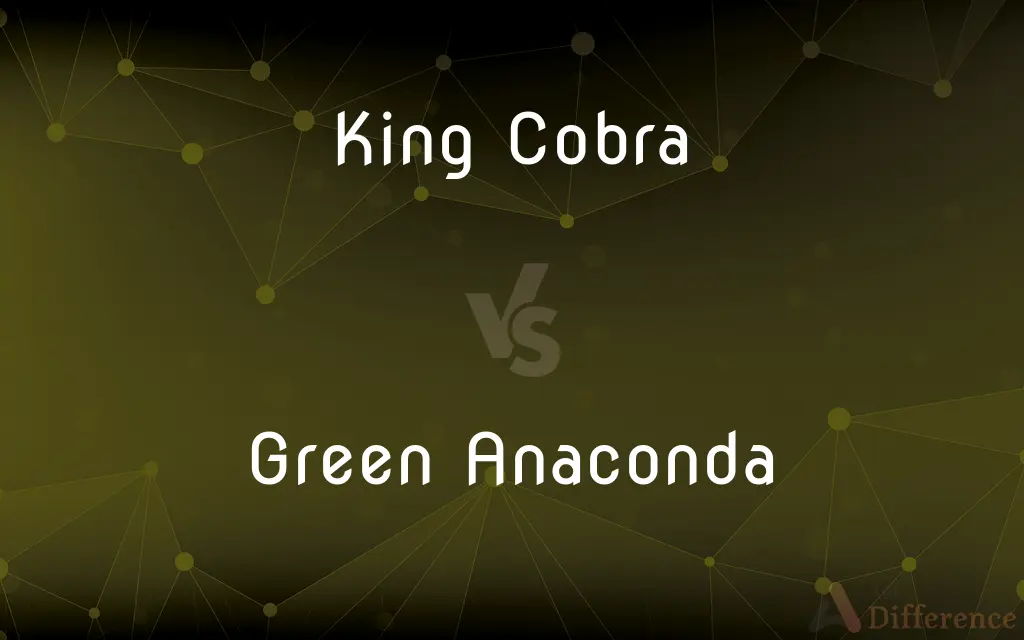King Cobra vs. Green Anaconda — What's the Difference?
By Tayyaba Rehman — Published on October 11, 2023
The King Cobra is a venomous snake native to Asia, while the Green Anaconda is a non-venomous, giant snake found in South America.

Difference Between King Cobra and Green Anaconda
Table of Contents
ADVERTISEMENT
Key Differences
King Cobra is renowned globally for its potent venom and intimidating hood, making it one of the most fearsome snakes in the world. Contrarily, the Green Anaconda, devoid of venom, leverages its colossal size and formidable constricting power to subdue prey and establish its reputation in the animal kingdom.
Habitating mainly in the forests of Southeast Asia, the King Cobra slithers as a solitary and highly venomous serpent, renowned for its capability to "stand" and look a human in the eye. In the lush, aquatic environments of the Amazon, the Green Anaconda thrives, utilizing its massive girth and length to navigate both land and water effortlessly.
Notably, the King Cobra lays eggs, a trait which is somewhat unusual among vipers, providing a distinctive reproductive contrast within the snake world. On the flip side, Green Anacondas are live-bearers, providing a stark dichotomy in reproductive methods when compared to their Asian counterpart.
The diet of a King Cobra predominantly features other snakes, making it an ophiophagous creature. Conversely, the Green Anaconda, due to its tremendous size, can prey upon a vast array of larger animals, such as deer, caimans, and even jaguars, exemplifying its predatory versatility.
While the King Cobra can extend itself and raise a third of its body off the ground, elevating its stature in a menacing posture, the Green Anaconda leverages its aquatic proficiency, often submerging itself with only its nostrils above water, to stalk prey undetected.
ADVERTISEMENT
Comparison Chart
Habitat
Forests of Southeast Asia
South American aquatic environments
Venom
Highly venomous
Non-venomous
Reproduction
Oviparous (lays eggs)
Viviparous (gives birth to live young)
Size
Can reach 18 feet
Can exceed 30 feet
Primary Prey
Mainly other snakes
Large animals, even caimans and deer
Compare with Definitions
King Cobra
King Cobras possess a neurotoxic venom, extremely lethal to their prey and dangerous to humans.
A bite from a King Cobra can be fatal if not promptly treated.
Green Anaconda
The Green Anaconda can swim and navigate skillfully in water.
Green Anacondas utilize water bodies in their habitat for hunting and mobility.
King Cobra
King Cobras can raise up to one-third of their bodies upright.
A raised King Cobra can look a standing human directly in the eye.
Green Anaconda
The Green Anaconda is one of the world’s largest and heaviest snakes.
A mature Green Anaconda can outweigh several adult humans.
King Cobra
Known for its hood, the King Cobra is a symbol of danger and reverence in many cultures.
The expansive hood of the King Cobra often serves as a warning signal to potential threats.
Green Anaconda
Native to South America, the Green Anaconda is largely aquatic.
Green Anacondas are often found lurking in the Amazon River.
King Cobra
The King Cobra is a large, venomous snake found in Asia.
The King Cobra, capable of reaching lengths up to 18 feet, is one of the world's longest venomous snakes.
Green Anaconda
Green Anacondas utilize constriction to subdue their prey.
A Green Anaconda coils around its prey, applying pressure to immobilize and eventually suffocate it.
King Cobra
The King Cobra primarily preys on other snakes.
King Cobras often hunt rat snakes within their territories.
Green Anaconda
Female Green Anacondas are significantly larger than their male counterparts.
Female Green Anacondas often dwarf the males in both length and girth.
Common Curiosities
Is the Green Anaconda venomous?
No, the Green Anaconda is not venomous and kills prey through constriction.
Are Green Anacondas endangered?
Currently, Green Anacondas are not classified as endangered but face threats from habitat loss and hunting.
Where is the King Cobra predominantly found?
The King Cobra is mainly found in the forests of Southeast Asia.
How does the King Cobra use its venom?
The King Cobra uses its potent neurotoxic venom to immobilize and kill its prey.
Are Green Anacondas solitary animals?
Yes, Green Anacondas are typically solitary, especially outside of the breeding season.
Is the Green Anaconda the largest snake in the world?
The Green Anaconda is considered the heaviest snake in the world and can be one of the longest.
Can Green Anacondas live in saltwater environments?
While they prefer freshwater habitats, Green Anacondas can tolerate brackish waters.
How large can a Green Anaconda get?
Green Anacondas can grow over 30 feet in length and weigh up to 550 pounds or more.
How do Green Anacondas give birth?
Green Anacondas give birth to live young, typically in litters of 20-40.
What is the primary diet of a King Cobra?
King Cobras mainly eat other snakes, earning them a classification as ophiophagous.
What is the lifespan of a King Cobra in the wild?
A King Cobra can live up to 20 years in the wild.
Are King Cobras protected in their native countries?
Yes, King Cobras are often protected by law due to their declining populations and vital role in local ecosystems.
How many eggs does a King Cobra typically lay?
A female King Cobra may lay between 20 and 40 eggs per clutch.
How long can a King Cobra survive without eating?
King Cobras can go several months without a meal, due to their slow metabolic rate.
How do locals regard the King Cobra in its native habitats?
The King Cobra is often revered and feared, featuring prominently in local myths and legends.
Share Your Discovery

Previous Comparison
Utilitarianism vs. Pragmatism
Next Comparison
Everyday vs. Every DayAuthor Spotlight
Written by
Tayyaba RehmanTayyaba Rehman is a distinguished writer, currently serving as a primary contributor to askdifference.com. As a researcher in semantics and etymology, Tayyaba's passion for the complexity of languages and their distinctions has found a perfect home on the platform. Tayyaba delves into the intricacies of language, distinguishing between commonly confused words and phrases, thereby providing clarity for readers worldwide.
















































